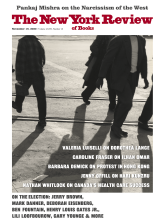Buried in a dense government report from 1975 is an observation that has come to haunt the American system of voting. “Effective Use of Computing Technology in Vote-Tallying,” a hundred-page compendium of all that can go wrong when digital technology is used to register and count votes, was written by Roy Saltman, a computer scientist, at the behest of the National Bureau of Standards.
At the time, computerized election technology was a shiny new thing, primed to replace time-honored manual ways of voting. But as Saltman observed, because this technology was beyond the comprehension of most election officials, they had little choice but to put their trust in, and cede authority to, equipment manufacturers. As a consequence, he wrote, “when vendors assume more responsibility than they should, due to the jurisdictions’ lack of in-house capability, situations may be created in which conflict of interest is a serious concern.” This is still true. The ever-increasing sophistication of digital election technology has left election officials ever more reliant on the vendors (and under the sway of their lobbyists), who play an outsized and largely hidden part in both the administration of elections and the ways we exercise our most fundamental right as citizens in a democracy.
In 2002, two years after misaligned punch-card voting machines in Florida threw the presidential election into disarray and the Supreme Court handed the victory to George W. Bush, Congress passed the Help America Vote Act (HAVA), which sent about $4 billion to the states to upgrade their voting equipment. Many jurisdictions rushed to replace aged voting machines with expensive computerized systems that ran on inscrutable, proprietary software. These “black boxes” have required both election officials and the public to take on faith that the machines are programmed to capture voter intent, not subvert it. When researchers have attempted to examine the computer code, they have been threatened with lawsuits by the election vendors.
Even so, computer scientists have uncovered numerous flaws that leave voting machines exposed to manipulation from both outside forces and insiders closer to home. These include machines that can be reprogrammed remotely or in person by surreptitiously (and easily) inserting fraudulent media cards or thumb drives, as researchers have shown over and over again.
Meanwhile, despite claims to the contrary by election vendors, it’s been demonstrated that ballot scanners in precincts in the swing states of Wisconsin, Michigan, and Florida use wireless modems that connect to the Internet. Internet connectivity, it should go without saying, leaves these precincts open to hacking. Jurisdictions that rely on digital “ballot-marking” voting machines that encode voters’ selections in an unreadable barcode present another vector of attack, since voters can’t know if the choices they believe they have made are the ones that actually have been recorded. (A ballot-marking device automates the “process” of filling in the oval next to a candidate’s name. It can be quite useful for voters with disabilities.) Election officials have been sold these machines believing that they provide the electorate with a paper trail, not understanding that the paper is worthless unless there is a statistically rigorous, postelection audit that compares the choices tabulated from the barcodes with the numbers recorded on paper.
These vulnerabilities—and others—inject doubt into the public’s perception of election integrity. That doubt is compounded by the fact that the three major election vendors in the United States—Election Systems and Software, Hart InterCivic, and Dominion—are owned by private equity. Together, they account for about 80 percent of all election equipment used in the United States. This leaves the public in the dark about who owns the voting machine companies, or how much money those owners make from elections.
At the very least, not knowing who is behind these companies—and if they have ties to either political party, donate to super PACs, or have a financial stake in the outcome of an election—undermines confidence in the proprietary software undergirding voting machines. The federal government, which does not participate in the administration of elections, could change this by requiring any election vendor paid with federal funds to disclose its full ownership and post its balance sheet. Until then, as Saltman warned, “situations may be created in which conflict of interest is a serious concern.”



